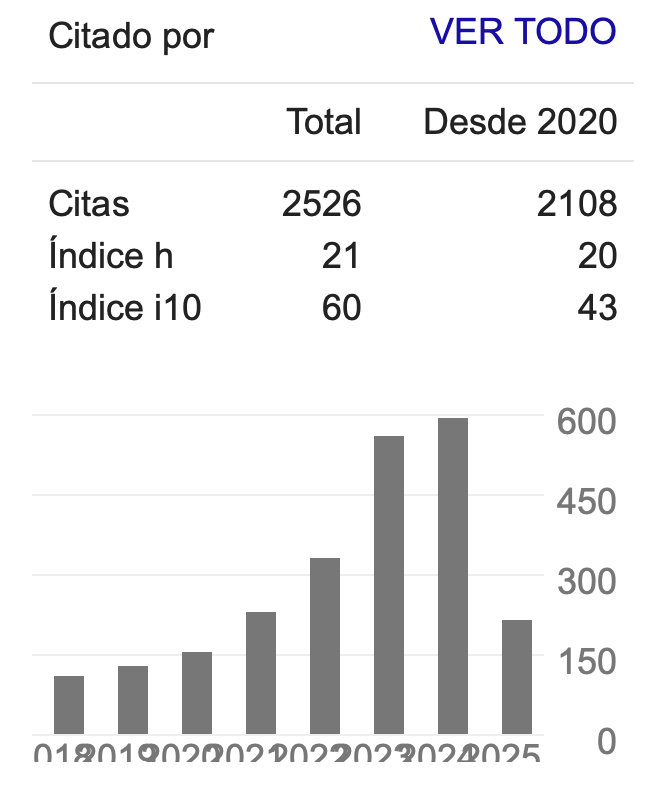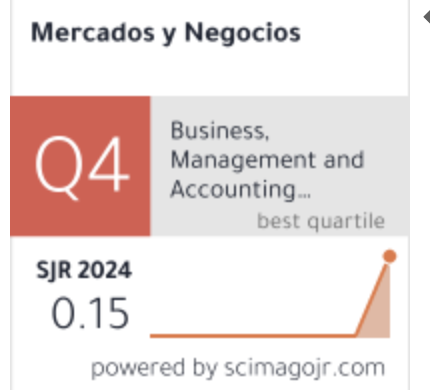Benefits of Digital Training Approaches on Non-Banking Economic Divisions in India
DOI:
https://doi.org/10.32870/myn.vi55.7771Keywords:
Digital training, online learning, employee performance, non-banking financial institutions, digital transformationAbstract
The current research examines the benefits of digital training approaches in non-banking economic divisions in India. The present study adopted quantitative analysis employing the SPSS version 23 software package. A structured questionnaire survey method is used to collect the data from employees working in the non-banking economic division, and a purposive sampling approach is used for analysis. The objective of the method is to collect data relating to employees' insights concerning adopting digital training. ANOVA, frequency, and regression tests are executed in research. The study's outcomes revealed the prevalence of digital training in non-banking institutions and the significance of online learning platforms in offering practical training to employees. Furthermore, the study also evaluates the impact of digital training approaches on employee performance in the organization. The study recommends implementing online learning platforms in non-banking financial institutions to accomplish organizational objectives.References
Al-Ghezawi, Y., & Megdadi, Y. (2021). The Impact Of E-Learning In Developing Employees Performance At Jordanian Commercial Banks. International Journal of Economics, Commerce and Management, 9(7).
Al-Shorman, H., Alshawabkeh, R., Aldaihani, F., Aityassine, F., Mohammad, A., & Al-Hawary, S. (2021). Drivers of E-training Intention to Use in the private universities in Jordan. International Journal of Data and Network Science, 5(4), 831-836.
Alber, N., & Saleh, A. (2020). The impact of COVID-19 spread on stock markets: the case of the GCC countries. International Business Research, 13(11).
Alghamdi, A., Alsuhaymi, D., Alghamdi, F., Farhan, A., Shehata, S., & Sakoury, M. (2022). University students’ behavioral intention and gender differences toward the acceptance of shifting regular field training courses to e-training courses. Education and Information Technologies, 27(1), 451-468.
Alhooti, M., & Anto, M. (2020). The effect of E-training on employee performance of Gulf Petrochemical Industries Company in the Kingdom of Bahrain. iKSP Journal of Innovative Writings, 1(1), 42-52.
Almubaydeen, T., Alkabbji, R., & Almarzoq, R. (2025). The Impact of Digital Transformation in Accounting on Financial Information Quality in Jordanian Commercial Banks. In From Machine Learning to Artificial Intelligence: The Modern Machine Intelligence Approach for Financial and Economic Inclusion (pp. 925–938). Springer.
Arshad, M., Abbas, K., & Gul, M. (2023). Examining the Influence of E-HRM Practices on Conventional Banks' Performance: A Focus on E-Recruitment, E-Training, and E-HR Evaluation. Contemporary Issues in Social Sciences and Management Practices, 2(2). https://doi.org/10.61503/cissmp.v2i2.36
Bagdi, S. (2022). Framework for the Adoption of Digital Transformation: A Study on the Banking and Financial Services Industry in India, SP Jain School of Global Management (India). ProQiuest
Bahl, K., Kiran, R., & Sharma, A. (2024). Evaluating the effectiveness of training of managerial and non-managerial bank employees using Kirkpatrick’s model for evaluation of training. Humanities and Social Sciences Communications, 11(1), 1-14.
Balogun, J., & Enemuo, C. (2022). The Role of E-Training on Human Resource Management Staff of Management Development Training Institutions. NDA Journal of Management Sciences Research, 2(2), 123-130.
Bansal, N. (2020). The impact of training programme of digital banking services to employees of unorganised sector and their acceptability in India. International Journal of Electronic Customer Relationship Management, 12, 246. https://doi.org/10.1504/IJECRM.2020.11004
Baur, N. (2019, June). Linearity vs. circularity? On some common misconceptions on the differences in the research process in qualitative and quantitative research. Frontiers in Education, 4 (53).
Berndt, A. (2020). Sampling methods. Journal of Human Lactation, 36(2), 224-226. https://doi.org/10.1177/0890334420906
Bikse, V., Lusena, I., Rivza, P., & Rivza, B. (2021). The development of digital transformation and relevant competencies for employees in the context of the impact of the COVID-19 pandemic in latvia. Sustainability, 13(16), 9233. https://doi.org/10.3390/su13169233
Bisht, N., Noronha, E., & Tripathy, A. (2025). Digital technologies exacerbating mission drift in microfinance institutions: Evidence from India. Information and Organization, 35(1), 100541. https://doi.org/10.1016/j.infoandorg.2024.100541
Campbell, S., Greenwood, M., Prior, S., Shearer, T., Walkem, K., Young, S., Bywaters, D., & Walker, K. (2020). Purposive sampling: complex or simple? Research case examples. Journal of research in Nursing, 25(8), 652–661. https://doi.org/10.1177/17449871209272
Contreras, F., & González, E. (2021). Business resilience and social inclusion: A critical reflection on internal marketing. Mercados y Negocios, 22(43), 77-96. https://doi.org/10.32870/myn.v0i43.7630
Deng, H., Duan, S., & Wibowo, S. (2023). Digital technology driven knowledge sharing for job performance. Journal of Knowledge Management, 27(2), 404-425. https://doi.org/10.1108/JKM-08-2021-0637
Dzwigol, H. (2020). Innovation in marketing research: quantitative and qualitative analysis, Marketing (1) 128–135.
El Omari, A., Tridane, M., & Belaaouad, S. (2022). Teacher e-training and student e-learning during the period of confinement caused by COVID-19 in case of Morocco. International Journal of Advanced Computer Science and Applications (IJACSA), 13(2). https://doi.org/10.14569/ijacsa.2022.0130294
Emter, L., Killeen, N., & McQuade, P. (2021). Bank and non-bank financial institutions’ crossborder linkages: New evidence from international banking data. Central Bank of Ireland.
Farrugia, B. (2019). WASP (write a scientific paper): Sampling in qualitative research. Early human development, 133, 69-71.
Hassan, A., Hassan, J., & Yen, T. (2020, April). E-training and development, motivation and employee performance among academicians: Case study of academicians in UniMAP. Journal of Physics: Conference Serie, 1529 (3) https://doi.org/10.1088/1742-6596/1529/3/032011
Hermawan, R., & Rahayu, E. (2025). Effect of Position Analysis and Competence on Employee Performance at BPR Prima Sejahtera. International Journal of Economics, Management and Accounting (IJEMA), 2(9). 799-804. https://doi.org/10.47353/ijema.v2i9.241
Heslina, H., & Syahruni, A. (2021). The influence of information technology, human resources competency and employee engagement on performance of employees. Golden Ratio of Human Resource Management, 1(1), 01-12. https://doi.org/10.52970/grhrm.v1i1.100
Ismail, F., Hazwani, N., Kee, K., & Yussof, M. (2022). The effect of e-training towards employee performance. Research in Management of Technology and Business, 3(1), 207-218.
Karamoy, H., & Tulung, J. (2020). The effect of financial performance and corporate governance to stock price in non-bank financial industry. Corporate Ownership & Control, 17(2)
Khan, S. (2023). A Systematic Approach on Customer Relationship Management Practices in Non-banking Companies. Journal of Informatics Education and Research, 3(2).
Khowaja, I., Talpur, U., Soomro, S., & Khan, M. (2021). The non-banking financial institutions in perspective of economic growth of Pakistan. Applied Economics Letters, 28(8), 701-706.
Kulkarni, P., Appasaba, L., Gokhale, P., & Tigadi, B. (2022). Role of digital simulation in employee training. Global Transitions Proceedings, 3(1), 149-156.
Kumar, A., & Kumar, S. (2022). Enhancing workforce agility through e-training to deal with a crisis: A themes-based content analysis. IUP Journal of Organizational Behavior, 21(2), 99-116.
Kumar, S., & Kumar, A. (2023). E-training impact on trainee experience and self-assessment. Journal of Workplace Learning, 35(7), 599-612.
Lakens, D. (2022). Sample size justification. Collabra: Psychology, 8(1), 33267..
Liang, G., Fu, W., & Wang, K. (2019). Analysis of t-test misuses and SPSS operations in medical research papers. Burns & Trauma, 7.
Ma, G., Yang, R., Minneyfield, A., Gu, X., Gan, Y., Li, L., Liu, S., Jiang, W., Lai, W., & Wu, Y. (2022). A practical analysis of blended training efficacy on organizational outcomes. Industrial and Commercial Training, 54(4), 637-646.
Md, S., Md Saiful, I., & Jannatul, F. (2025). Harnessing AI Adoption in the Workforce A Pathway to Sustainable Competitive Advantage through Intelligent Decision-Making and Skill Transformation. American Journal of Economics and Business Management, 8(3), 954-976.
Mohajan, H. (2020). Quantitative research: A successful investigation in natural and social sciences. Journal of Economic Development, Environment and People, 9(4), 50-79.
Muduli, A., & Choudhury, A. (2024). Digital technology adoption, workforce agility and digital technology outcomes in the context of the banking industry of India. Journal of Science and Technology Policy Management. https://doi.org/10.1108/JSTPM-01-2024-0018
Nazuri, S., Mohamed, I., & Daud, N. (2025). Survival determinants of Fintech firms in Malaysia-moderating role of Fintech experience. Technological Forecasting and Social Change, 211, 123922. https://doi.org/10.1016/j.techfore.2024.123922
Papanko, V. (2022). Internal Audit Effectiveness and the Financial Performance of Non-banking Financial Institutions in Ashanti Region of Ghana. Doctoral dissertation, University of Cape Coast
.
Rodrigues, L., Oliveira, A., & Rodrigues, H. (2023). Technology management has a significant impact on digital transformation in the banking sector. International Review of Economics & Finance, 88, 1375-1388.
Samantaray, S., Kumar, D., Farhan, M., & Kumar, S. (2023). Assessment of E-Training in Developing Resilience to Adopt E-Nam Technology: A Case Study of Farmers' Development in Odisha, India. resmilitaris, 13(3), 137-157.
Sapta, I., Muafi, M., & Setini, N. (2021). The role of technology, organizational culture, and job satisfaction in improving employee performance during the Covid-19 pandemic. The Journal of Asian Finance, Economics and Business, 8(1), 495-505.
Selase, E., & Avenorgbo, M. (2021). The effect of e-training on the performance of employees in small and medium scale enterprise amidst the COVID-19 pandemic. Acta Universitatis Bohemiae Meridionalis, 24(2), 34-48.
Shahriar, S., Arafat, S., Islam, I., Nur, J., Rahman, S., Khan, S., & Alam, M. (2023). The emergence of e-learning and online-based training during the COVID-19 crisis: an exploratory investigation from Bangladesh. Management Matters, 20(1), 1-15.
Steggemann, M. (2023). Collective Intelligence synergizing into Collective Resilience. Mercados y Negocios, 24(49), 65-82. http://orcid.org/0009-0004-8334-389X
Stratton, S. (2021). Population research: convenience sampling strategies. Prehospital and disaster Medicine, 36(4), 373-374.
Sultanova, M., Sultanov, A., Zhangaliyeva, Y., Zhanibekova, G., Ordabayeva, M., Zamanbekova, A., ... & Primbetova, S. (2024). Identifying features of the level of digitalization of banking services in different countries. Eastern-European Journal of Enterprise Technologies, 5(13 (131)), 58-66.
Sürücü, L., & Maslakci, A. (2020). Validity and reliability in quantitative research. Business & Management Studies: An International Journal, 8(3), 2694-2726.
Tusa, E., & Dumitrescu, L. (2025). Digital Interactive Technologies and Platforms Used in Formal Education Networks. In Changes and Innovations in Social Systems (pp. 279-293). Cham: Springer Nature Switzerland.
Usmia, S., LC, M., Nuryanto, U., & Lubis, F. (2024). Analysis of The Influence of Digital Integrated Employee System on Employee Performance in Banking Industry. Jurnal Informasi dan Teknologi, 6 (2), 7-11. https://doi.org/10.60083/jidt.v6i2.522
Verma, J. (2024). The influence of online marketing services on non-banking finance companies (nbfcs). Anweshan, 7(1), 68-76.
Wavre, S., & Kuknor, S. (2024). Enhancing effectiveness of online training program through assessment of participant engagement index. Development and Learning in Organizations: An International Journal, 38(1), 4-8.
Wiradendi, C., Solikhah, S., Fidhyallah, N., & Lestari, D. (2020). Effectiveness of e-training, e-leadership, and work life balance on employee performance during COVID-19—Journal of Asian Finance, Economics and Business, 7(10).
Published
How to Cite
Issue
Section
License
Copyright (c) 2025 Palak Dev, Garima Sainger

This work is licensed under a Creative Commons Attribution-NonCommercial 4.0 International License.
Mercados y Negocios by Department of Mercadotecnia y Negocios Internacionales. University of Guadalajara is licensed under a License Creative Commons Attribution-NonCommercial 4.0 International.
The author retains the copyright.








